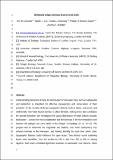Enhanced pelagic biomass around coral atolls
Abstract
Understanding the processes driving the distribution of mid-water prey such as euphausiids and lanternfish is important for effective management and conservation. In the vicinity of abrupt topographic features such as banks, seamounts and shelf-breaks, mid-water faunal biomass is often elevated, making these sites candidates for special protection. We investigated the spatial distribution of water column acoustic backscatter - a proxy for macrozoo - plankton and fish biomass - in the 9 km transition zone between the pelagos and coral atolls in the Chagos Archipelago (6° N, 72° E). The purpose was to determine the magnitude and distance over which bathymetry may enhance biomass in the mid-water, and thereby identify the scale over which static topographic features could influence the open ocean. Two distinct sound scattering layers were identified, from the surface to 180 m and from 300 to 600 m, during daytime. Both layers exhibited significant increases in backscatter near features. Close to features, the shallow layer backscatter was ca. 100 times higher and was driven partly by increasing numbers of larger individuals, evident as single target echoes. We determine the regional scale of influence of features on pelagic biomass enhancement to be ca. 1.8 km in the Chagos Archipelago, and suggest possible ecological explanations that may support it. Our approach determining the scale of influence of bathymetry should be applied during the process of marine reserve design, in order to improve protection of mid-water fauna associated with topographical features, such as seamounts and coral reefs.
Citation
Letessier , T B , Cox , M J , Meeuwig , J J , Boersch-Supan , P H & Brierley , A S 2016 , ' Enhanced pelagic biomass around coral atolls ' , Marine Ecology Progress Series , vol. 546 , pp. 271-276 . https://doi.org/10.3354/meps11675
Publication
Marine Ecology Progress Series
Status
Peer reviewed
ISSN
0171-8630Type
Journal article
Description
T.B.L. was supported by the Marine Biodiversity Hub through the Australian Government’s National Environmental Research Program (NERP). P.H.B.-S. was supported by a Cusanuswerk doctoral fellowship, a Lesley & Charles Hilton-Brown Scholarship, University of St. Andrews, and a grant from the Fisheries Society of the British Isles. M.J.C. was supported by Australian Research Council grant FS110200057.Collections
Items in the St Andrews Research Repository are protected by copyright, with all rights reserved, unless otherwise indicated.

